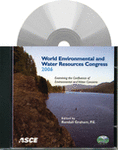Using Genetic Algorithms and Particle Swarm Optimization for Optimal Design and Calibration of Large and Complex Urban Stormwater Management Models
Publication: World Environmental and Water Resource Congress 2006: Examining the Confluence of Environmental and Water Concerns
Abstract
Computer models are vital for the evaluation and management of urban drainage systems. Usefulness of these models, however, depends on how well they are calibrated. Properly calibrated models can be used to conceive, evaluate and compare various design improvement alternatives. Unfortunately, calibration and design of urban stormwater models, especially with the commonly used trial-and-error approach, are an expensive, time-consuming process and normally represent the most painful step of a modeling exercise. Their success depends mainly on the engineering expertise of the modeler and budget availability. The effort is complicated by the fact that these models normally necessitate the evaluation of a large number of variables and parameters in order to adequately describe the complex relationships that exist between rainfall, runoff, watershed characteristics, and system hydraulics in an urban setting. The trial-and-error evaluation of all calibration and design/improvement options is therefore unlikely to be practically feasible or manageable, and even knowledgeable modelers often fail to obtain good results. In this paper, a rigorous optimal calibration and design methodology is presented, which eliminates the need of the traditional trial-and-error technique. The optimal calibration and design problems are cast as nonlinear optimization problems and solved using genetic algorithms (GA) optimization and particle swarm optimization (PSO). The EPA storm water management model (SWMM5) is employed to perform hydrologic and hydraulic analyses. The optimal calibration model determines the set of calibration parameters that best matches field observations of flow, depth or velocity to accurately mirror actual system performance. The optimal design model determines the set of design parameters that best meets desired system performance requirements at minimum cost. Design parameters can include any combination of pipe slope and size, storage, pumping, and new piping. System performance criteria include explicit constraints on the maximum allowable depth to diameter ratio, minimum and maximum pipe velocities, and maximum head loss for force mains. The proposed optimal calibration and design models are demonstrated by application to an example urban stormwater collection system. Enhancement of urban drainage system planning, design, operation and management is a principal benefit of the proposed methodology.
Get full access to this chapter
View all available purchase options and get full access to this chapter.
Information & Authors
Information
Published In
Copyright
© 2006 American Society of Civil Engineers.
History
Published online: Apr 26, 2012
ASCE Technical Topics:
- Algorithms
- Calibration
- Computer models
- Design (by type)
- Engineering fundamentals
- Engineering materials (by type)
- Environmental engineering
- Hydraulic design
- Infrastructure
- Materials engineering
- Mathematics
- Measurement (by type)
- Models (by type)
- Optimization models
- Particles
- Stormwater management
- Urban and regional development
- Water treatment
Authors
Metrics & Citations
Metrics
Citations
Download citation
If you have the appropriate software installed, you can download article citation data to the citation manager of your choice. Simply select your manager software from the list below and click Download.
